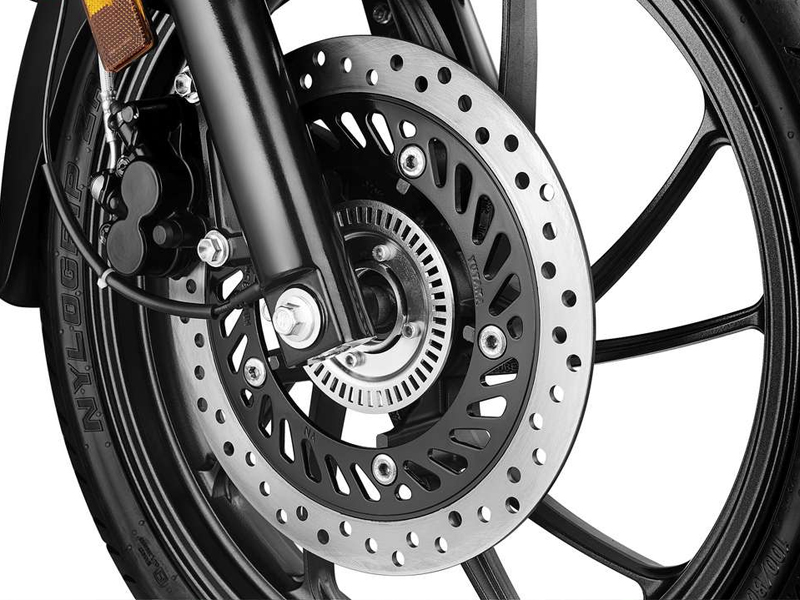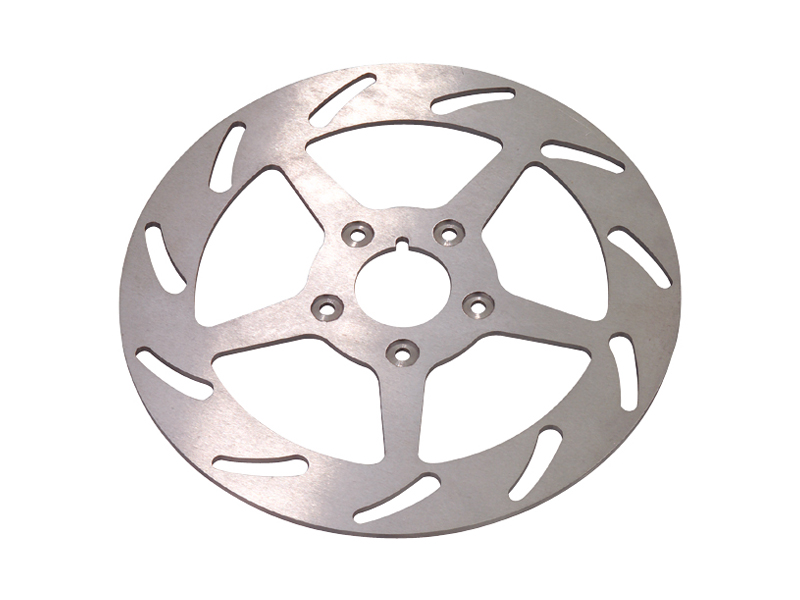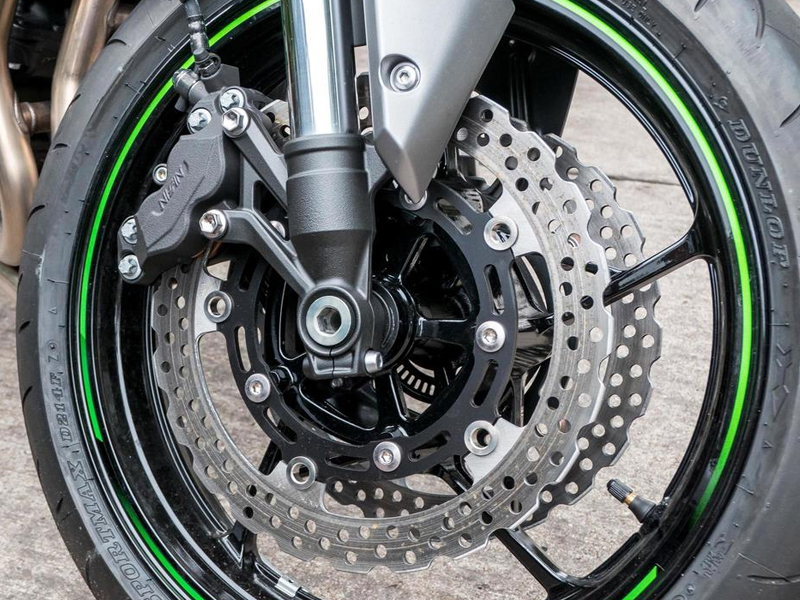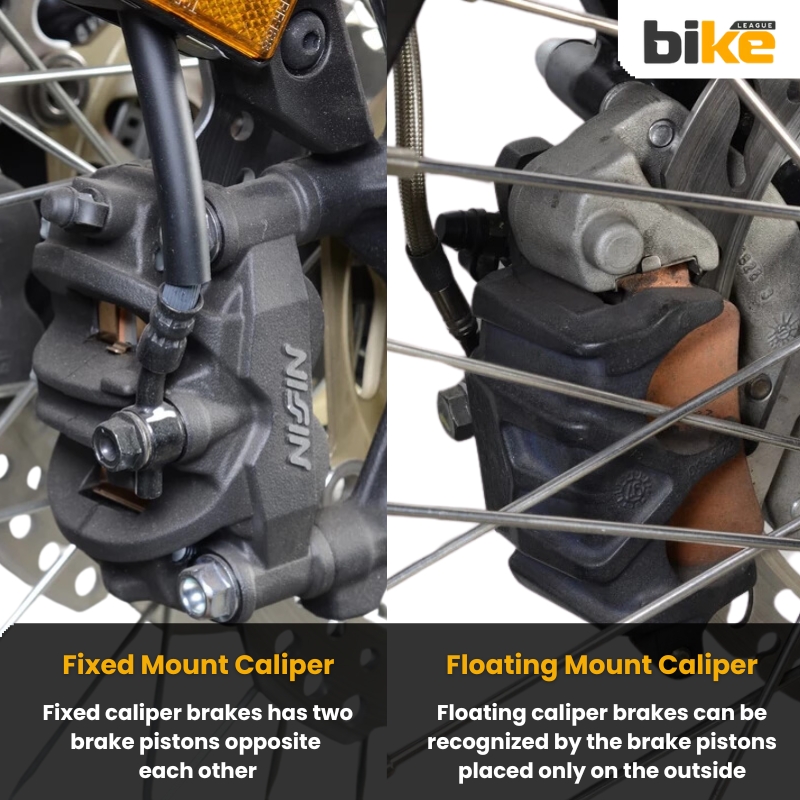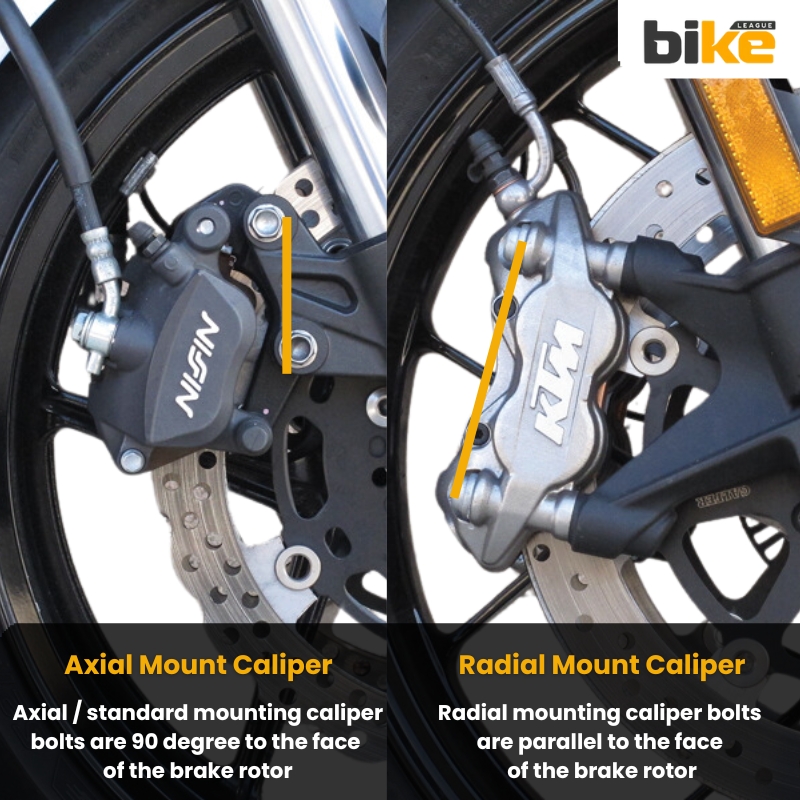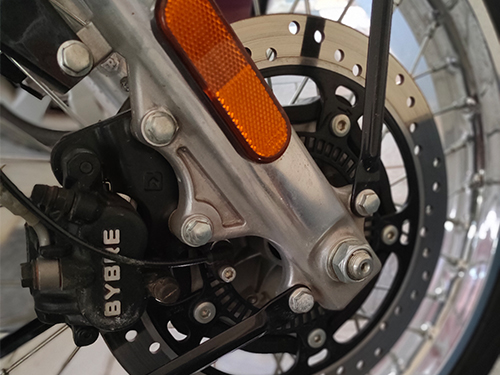
Long story short: the disk brake in a bike is an essential component of any bike. Learn about motorcycle disc brakes and their types in this comprehensive guide.
A disc brake is now a key part of a motorcycle. Even budget bikes now have at least a front disc brake. Drum brakes on both wheels are a thing of the past. Customers want more safety features. Technology has evolved quickly, and ABS is now mandatory for bikes over 150cc. Premium bikes may feature single- or dual-channel ABS, depending on the price and other factors.
Disc brake designs can vary between premium, race-track, and standard motorcycles. Each bike utilises a specific type of disc brake, depending on its intended use. This article covers the main types of motorcycle disc brakes, their maintenance, frequently asked questions, and the pros and cons. Use this as a comprehensive guide to motorcycle disc brakes.
Key Takeways
- Slotted and drilled rotors both shed water well for better initial bite; slotted rotors have an advantage in keeping the disc clear of debris and water.
- Petal and slotted rotors dissipate heat very efficiently, reducing fade in aggressive riding or track use. Drilled rotors help but may risk cracking under repeated, heavy use.
- Slotted and petal rotors wear pads faster due to the aggressive surface and increased cleaning action. Fixed and radial callipers offer more even wear compared to floating/axial types.
- Radial/fixed callipers reduce flex, improving braking precision and lever feel; floating/axial callipers are cheaper, adequate for daily use, but flex under heavy braking.
How do motorcycle disc brakes work?
The front brake lever activates the master cylinder, which pushes a piston to pressurise the brake fluid. This pressure travels through the brake lines to a piston in the calliper, which presses the brake pads against the rotor. The friction between the pads and rotor slows the bike.
Different types of motorcycle disc brakes
1. Cross drilled rotor
Cross-drilled rotors feature multiple holes drilled perpendicularly through the brake disc. The primary goal is to improve airflow and cooling, while also channelling away water and gases that can form during aggressive braking.
Advantages of the cross-drilled rotor
- Improved Heat Dissipation: Drilled holes act as vents to help hot air and gases escape, reducing the risk of brake fade during repeated hard stops.
- Water Dispersion: The holes clear water from the disc surface, providing better initial bite in the rain.
- Enhanced Aesthetics: Drilled rotors are lighter than solid discs, slightly improving suspension response and handling.
- Sporty Appearance: For many riders, the visually aggressive style is a bonus.
Disadvantages of the cross-drilled rotor
- Prone to Cracking: Under extreme heat cycles and heavy braking (like on track days), cracks can develop around the holes.
- Increased Pad Wear: Sharp edges at the hole boundaries can wear pads more quickly than plain rotors.
- Limited Self-Cleaning: Compared to slotted rotors, drilled types are less effective at scraping debris off pad surfaces.
2. Cross slotted rotor
Slotted rotors have machined linear channels (“slots”) on the friction surface. These slots run to the edge of the disc and physically scrape the pads as they pass.
Advantages of the Cross slotted rotor
- Excellent Debris Removal: Slots channel away dust, debris, and gases for a cleaner, fresher pad/disc interface.
- Superior Performance in Wet Conditions: Water is quickly moved off the surface, restoring maximum brake effectiveness rapidly.
- Better Initial Bite: The edges of the slots enhance contact for sharper braking response in all conditions.
- Reduced Glazing: Slots help prevent brake pad glazing, which can occur after frequent heavy use and leads to poor braking.
Disadvantages of the Cross slotted rotor
- Greater Pad Wear: The scraping effect increases brake pad consumption.
- Slightly Heavier: Slotted designs don’t shed as much material as drilled, so weight reduction is less.
- Can Be Noisier: Some riders notice increased noise during braking.
3. Petal rotor or Wave disc
Petal rotors, also known as wavy or scalloped rotors, have a unique edge design that improves cooling and reduces weight. The outer edge of the rotor has a wave-like shape, rather than a plain circle.
Advantages of the petal disc rotor
- Exceptional Cooling: The wave pattern draws air over a larger area, rapidly cooling the disc.
- Lightest Design: Petal rotors are often lighter than both drilled and slotted types, reducing unsprung weight for more responsive handling.
- Improved Debris Clearing: The sharp profile edge is effective at pushing away dirt and dust.
- Distinct Aesthetic: Many riders like the aggressive, modern looks.
Disadvantages of the petal disc rotor
- Fastest Pad Wear: The aggressive edge causes brake pads to wear out more quickly.
- Higher Cost: Manufacturing complexity and performance orientation increase price.
- Noise: Whirring noises at higher speeds are possible, especially as the wave passes through the calliper.
4. Floating Mount Calipers
A floating calliper slides side-to-side on guide pins with each application of the brake. Only one side of the calliper is directly actuated by hydraulic pressure; the opposite pad is forced against the disc by the calliper’s movement.
Pros of Floating Mount Calipers
- Cost-Effective: Simpler to design and produce—used on most mainstream motorcycles.
- Self-Centering: Sliding action ensures both pads engage evenly.
- Lightweight: Less material leads to a lighter overall system.
- Easier Maintenance: Fewer components mean lower maintenance costs.
Cons of Floating Mount Calipers
- Some Flex/Deflection: Hard stops may expose some calliper movement, resulting in a less direct, “spongier” brake feel.
- Lower Maximum Performance: Not as rigid as fixed/radial callipers, so ultimate braking force is slightly less.
- Potential Uneven Pad Wear: Pins must remain clean and lubricated, or pads can wear unevenly.
5. Fixed Mount Callipers
Fixed callipers are bolted solidly in place and use pistons on both sides to squeeze the brake pads. No sliding parts—braking pressure is delivered directly and evenly.
Pros of Fixed Mount Calipers
- Superior Stopping Power: Both pads are driven with equal force, maximising stopping capability.
- Direct Feel: No caliper flex translates to very precise lever feedback.
- Even Pad Wear: Both pads contact the disc equally on every application.
- Performance-Oriented: Preferred in high-performance and heavy-duty motorcycles.
Cons of Fixed Mount Calipers
- Heavier: More material and complex design means added weight.
- More Expensive: Complexity raises both purchase and maintenance costs.
- Maintenance: More moving parts can be more challenging to service.
6. Radial Mount Calipers
Radial mount callipers are mounted to the motorcycle’s fork with bolts parallel to the wheel’s radius. This design offers better rigidity and braking efficiency.
Pros of Radial Mount Calipers
- Maximum Rigidity: Virtually no flex under heavy braking loads.
- Outstanding Performance: Ideal for racing and aggressive riding due to precise feedback.
- Accommodates Bigger Discs/Calipers: Allows easy upgrades for improved braking.
- Superior Pad Wear: Delivers even, consistent pad usage.
Cons of Radial Mount Calipers
- High Cost: Primarily found on premium or high-performance motorcycles.
- Complex Installation: Not easily retrofitted to all frames/bikes.
- Weight: Can be heavier than basic axial floating systems, but less so than some fixed systems.
7. Axial Mount Calipers
Axially mounted callipers are attached parallel to the fork, the most conventional setup. The calliper bolts run perpendicular to the disc face.
Pros of Axial Mount Calipers
- Cost-Effective: Simpler mounting—the industry standard for most motorcycles.
- Adequate for Most Uses: Capable of performing very well in everyday riding.
- Compatibility: Broad aftermarket and OEM support.
- Simpler Servicing: Basic tools and skills can usually handle maintenance.
Cons of Axial Mount Calipers
- Some Flex: Under heavy braking, the system may deflect slightly, which can reduce feel.
- Less Precise: Does not offer the same sharpness as radial mounts, especially under extreme loads.
- Limited Upgradability: Not ideal for oversized caliper/disc upgrades.
Tablewise Comparison of different types of motorcycle disc brakes
| Type | Dry Performance | Wet Performance | Heat Dissipation | Weight | Pad Wear | Cost | Notes |
|---|---|---|---|---|---|---|---|
| Cross Drilled Rotor | Good | Good | Moderate | Lighter | Normal | Moderate | May crack under high stress; visually appealing. |
| Cross Slotted Rotor | Very Good | Very Good | High | Heavier | Faster | Higher | Keeps pads cleaner; longer disc life. |
| Petal/Wave Rotor | Very Good | Good | Excellent | Lightest | Faster | High | Best cooling and weight; wears pads faster. |
| Floating Mount Caliper | Good | Good | Moderate | Lighter | Normal | Lower | Common on entry bikes, slight flex, less bite. |
| Fixed Mount Caliper | Excellent | Excellent | High | Heavier | Even | High | Superior stopping power and pedal feel. |
| Radial Mount Caliper | Excellent | Excellent | High | Heavier | Even | High | Less flex, best brake feedback, used on high-end bikes. |
| Axial Mount Caliper | Very Good | Very Good | Moderate-High | Moderate | Uneven | Moderate | More flex, slightly less feedback, but cost-effective. |
FAQ related to motorcycle disc brakes
1. What are the differences between single and dual disc brakes?
Single-disc brakes use one rotor and calliper per wheel, which is sufficient for most motorcycles and provides adequate stopping power for everyday riding. On the other hand, dual disc brakes use two rotors and callipers per wheel, offering enhanced braking performance, and are typically found on high-performance motorcycles.
2. What are floating discs, and how do they differ from fixed discs?
Floating discs feature a rotor blade that can move independently of the carrier, enabling better heat dissipation and reduced warping under extreme conditions. Fixed discs, made from a single piece of steel, are more cost-effective but less efficient in managing heat.
3. How do slotted or drilled discs improve braking performance?
Slotted or drilled discs feature holes or slots that facilitate better heat dissipation and water evacuation, thereby enhancing braking performance, particularly in wet conditions. These features make them ideal for high-speed or performance-oriented riding.
4. What are the benefits of using high-carbon or ceramic composite discs?
High-carbon or ceramic composite discs offer superior heat resistance and durability compared to standard steel discs. These materials are particularly beneficial for riders who engage in high-performance or track riding, as they can withstand higher temperatures without degrading their performance.
5. How do axial-mount callipers differ from radial-mount callipers?
Axial mount callipers are bolted perpendicular to the disc, a traditional mounting method. Radial mount callipers are bolted parallel to the disc, providing a more rigid setup that can improve braking performance and feel.
6. How do floating mount callipers differ from fixed mount callipers?
Floating callipers are designed to move slightly relative to the disc. This movement allows the calliper to self-centre over the rotor, ensuring even pad wear and consistent braking performance. Fixed callipers are rigidly mounted and do not move relative to the disc.
7. How does the disc size in the bike affect the braking force?
In simple terms, the larger the diameter of the motorcycle brake disc, the larger the force available to stop the motorcycle.
8. Why do motorcycle brake discs have holes?
The holes in a disc brake
- enable the brake to dissipate heat and perform optimally.
- Aid in removing water and dirt between the disc and brake pads
- Increases braking effectiveness
- Reduces wear
- Reduces brake weight
9. When should the disk brake plate in the bike be changed?
Replace the front disc if it is worn more than 1mm on either side. Replace the rear disc if it is worn by over 0.5mm to 0.75mm. For best safety, change both discs at the same time. Check every six months or at every service, regardless of the number of kilometres.
10. When should I change the disk brake pads on my bike?
Replace your disc brake pads when there’s 1.5mm or less of braking material remaining. Check every six months or at every general service, rather than a specific km range, for a safer approach.
11. Why does a motorcycle disc brake make noise?
Noise can be generated for various reasons, mainly because your brake pads are worn. If the pads are worn down to the bare metal, you’ll hear metal rubbing on the disc rotor. Replace the brake pad as soon as possible.
12. What causes motorcycle disc brakes to squeal?
In most cases, worn brake pads are the primary reason. Poor brake calliper alignment, contaminated pads, a bent disc rotor, and other issues are also reasons for the squealing of bike disc brakes. All these issues can only be identified by skilled technicians, making it never a DIY task.
13. How to clean a disk brake on a bike?
In most cases, there is no need to clean the disc brake rotor, as it is automatically cleaned by the brake pads during operation. But if oil or any other residue is on the disc rotor, use a dedicated automotive shampoo.
14. Can we adjust the disk brake on the bike?
No, you cannot adjust brake tightness manually. Motorcycle disc brakes use fluid pressure. If braking is poor, there is likely a loss of brake fluid pressure. Refill brake oil and check for leaks or air pockets. The brakes self-adjust once the oil is topped up.
15. How long do bike disk brake pads last?
There is no fixed km change interval for brake pads; instead, brake pads should be checked for every general service or every six months. Several factors can affect the lifespan of brake pads, including the number of kilometres ridden, riding environment, and riding style. Therefore, do not just focus on the km change interval.
16. How long do bike discs last?
There is no fixed kilometre change interval for brake discs; instead, check the brake pads once during a general service within a year or once a year. Several factors can affect the lifespan of brake discs, including the distance ridden, riding environment, and riding style. Therefore, do not just focus on the km change interval.
Other related articles from Bikeleague India
- Braking in motorcycle – All expert tips for bikers
- What is Motorcycle ABS? – Doubts, Queries and FAQ
- Engine braking in bikes: Detailed guide for riders
- Bike riding in summer in India – Tips to beat the heat
- QJ Motor SRK 400
Conclusion
This article discusses the various types of motorcycle disc brakes, their advantages and disadvantages, and addresses common questions. For further questions, contact us at bikeleague2017@gmail.com or leave a comment below. We are available to assist you. You can also reach us on Bikeleague India’s social media platforms.

